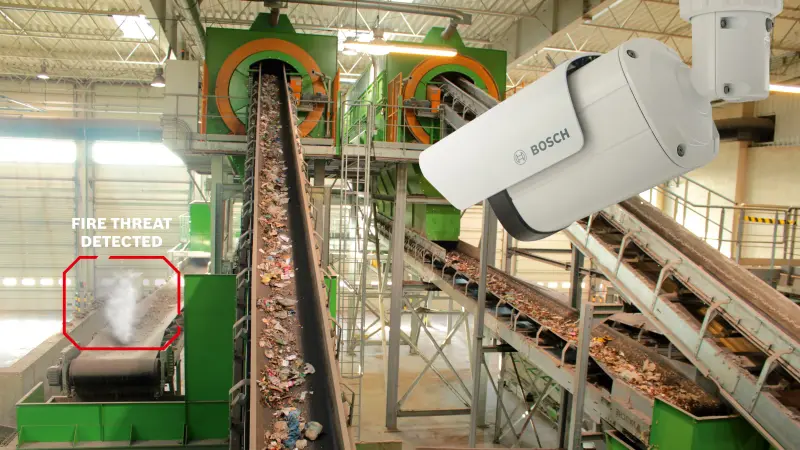
Overcoming the challenges of fire safety in the waste and recycling industry with Bosch
Facilities for managing waste and processing recyclable materials often comprise a perfect cocktail of kindling and conditions to spread a fire. This requires highly reliable fire detection – AVIOTEC fire and smoke detection camera keeps constant watch for the first signs of flames or smoke.
Waste is a feature of every premises, from residential to industrial. How this waste is handled varies between countries and regions. Entire companies make it their business to accept and process trash. Some sort and recycle materials such as plastics, paper and glass. Some collect or receive anything considered of potential value for its parts and components, including electrical appliances and battery-operated devices. Others still collect mixed or non-recyclable garbage and take it to their landfill or incineration facilities. The unpredictable combination of materials and substances which end up on waste management sites, plus the conditions and operational activities, make them hazardous environments with continual high fire risks.

“We needed additional fire monitoring at our wastepaper headquarters. Standard fire detection systems have their limits and huge amounts of dry dust are generated on our premises.”
Head of Fire Department at AVIOTEC customer, Mohn Media Print Factory
Huge dangers from battery buttons
In recent decades, lithium batteries have been used more than ever in portable, handheld devices, toys and gadgets. The small button batteries are also inserted in greeting cards providing audio or animation. These are often unwittingly disposed of incorrectly either in recycling – and due to the glitter or glued-on elements, the cards cannot be recycled as paper – or thrown into general waste bins with the battery still inside. These batteries can easily ignite or spread a fire, or even combust if overheated.
Hazardous hand gels
Even before the Covid-19 pandemic, consumers could purchase antibacterial hand soaps, gels and wipes for everyday usage. Sales of these items have increased massively, however, since 2020. In addition, now every premises receiving an influx of visitors, from shops and cafes to hotels and office buildings, provide hand dispensers. Surfaces are wiped with similar antibacterial cleaning agents. These products typically contain 60-70% alcohol, making them extremely flammable. For the healthcare profession, WHO even provides guidelines on their storage, use and disposal, including: “Risk assessments should be carried out on the use of alcohol hand-rubs … and the disposal of used containers/dispensers and expired stock, giving consideration to the risks of fire.” But average consumers throw away used wipes in their regular trash, and perhaps recycle plastic gel bottles, adding further to fire risks on waste management sites.
High-pressured environment
Frequently disposed items can pose risks of explosions or cause flames to spread within seconds. Aerosol cans, remnants of cosmetic or cleaning products, cigarette lighters and broken gadgets all contribute to mountains of garbage. Sources of heat and movement – excavators, sorting conveyor belts or compactor machinery, strong sunlight, wind tunnels between constructions and waste piles, and human activity on site – all have the potential to shift and stir this cocktail of fire hazards. On ignition, the flames are likely to be fed continuously by the waste itself and dry, dusty conditions. This allows fires to spread over a wide area within minutes, posing danger to life and the environment with the flames, toxic billowing smoke from burning chemicals or materials.
Insufficient safeguarding outside
Another feature of waste management and processing sites is that many of these premises are completely or partially outdoors. There’s a further risk of people dumping unsorted trash outside of operational hours, which could include flammable materials or substances their regular trash collection will not accept. In addition, not only windy conditions and harsh sunlight can trigger smoldering and ignite fires. These open areas are open to attack by arsonists, especially overnight. Flames won’t stop at the perimeter of the business site – they will continue ravaging around and through any buildings and machinery in their way. Even when firefighters arrive on site, the speed of fires on waste plants often means it is too late to salvage anything.
Applying AVIOTEC to the waste and recycling industry
Mohn Media Mohndruck GmbH, based in Gütersloh, Germany, provide offset printing services with customized solutions for their clients. This means they deal with masses of paper every day. They are part of the Bertelsmann Printing Group, who have been a Bosch Security and Safety customer for 35 years. The company’s fire department needed a special fire monitoring solution for their huge wastepaper warehouses, with eight-meter-high ceilings, which frequently store around 300 metric tons of paper. The height of these constructions meant a usual smoke detector would be too slow to pick up any burning vapor. Bosch installed AVIOTEC video cameras for a rapid solution to alert against detected smoldering or kindling. Jörg Naumann, the Head of the Fire Department at Mohn Media, says he and his colleagues are continuously “impressed by the innovative solutions that Bosch comes up with” to address their fire safety concerns.
The Bosch AVIOTEC IP starlight 8000 sets new standards in visual fire detection by combining reliable smoke and flame detection with outstanding speed. Learn more about this unique camera here.
